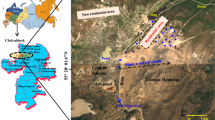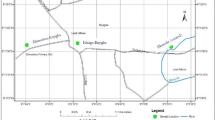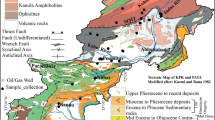Abstract
Soil and the dominant plant species in the vicinity of Khatoon Abad copper smelter in Kerman province of Iran are examined to determine contamination, bioavailability, and ecological-health risk of potentially toxic elements (PTEs) based on 23 collected soil samples and 13 Artemisia siebri plant species. Cu, Mo, As, and Sb display a significant level of enrichment in soil. Ecological risk assessment shows that Cu, As, and Cd pose the highest ecological risk. The results of PTEs fractionation reveal that, on average, Cu, As, Cd, Pb, Zn, and Mo are mostly distributed between non-residual fractions reflecting higher mobility and potential ecological risk, while Cr, Ni, and Co are significantly distributed within the residual fraction, and do not pose a serious ecological risk. Mobility factor suggests high bioavailability of Cu for plants followed by As, Cd, Pb, Mo, Co, Ni, and Cr. Biological accumulation coefficient displays higher phytoavailability of Mo and Cd. PTEs transfer within plant follows the order of Mo > As > Pb > Zn > Cu > Ni > Co > Cr > Cd. The results of phytoavailability indicate the high tendency of Cd to bioaccumulate in Artemisia’s root, while Mo, As, and Pb tend to translocate towards Artemisia’s shoot. Calculated hazard index and incremental lifetime cancer risk revealed that As poses the highest non-carcinogenic health risk, and As and Pb pose the greatest carcinogenic health risk in both adults and children.






Similar content being viewed by others
References
Alloway, B. J., Thornton, I., Smart, G. A., Sherlock, J. C., & Quinn, M. J. (1988). The Shipham report. An investigation into cadmium contamination and its implications for human health. Metal availability. The Science of the Total Environment, 75(1), 41–69.
Antoniadis, V., Shaheen, S. M., Boersch, J., Frohne, T., Du Laing, G., & Rinklebe, J. (2017). Bioavailability and risk assessment of potentially toxic elements in garden edible vegetables and soils around a highly contaminated former mining area in Germany. Journal of Environmental Management, 186, 192–200.
Antoniadis, V., Golia, E. E., Liu, Y.-T., Wang, S.-L., Shaheen, S. M., & Rinklebe, J. (2019). Soil and maize contamination by trace elements and associated health risk assessment in the industrial area of Volos, Greece. Environment International, 124, 79–88.
Baker, A. J. M., & Brooks, R. (1989). Terrestrial higher plants which hyperaccumulate metallic elements. A review of their distribution, ecology and phytochemistry. Biorecovery., 1(2), 81–126.
Berberian, M., & King, G. C. P. (1981). Towards a paleogeography and tectonic evolution of Iran. Canadian Journal of Earth Sciences, 18(2), 210–265.
Bing, H., Wu, Y., Zhou, J., Sun, H., Wang, X., & Zhu, H. (2019). Spatial variation of heavy metal contamination in the riparian sediments after two-year flow regulation in the three gorges reservoir, China. Science of the Total Environment, 649, 1004–1016.
Boomeri, M., Nakashima, K., & Lentz, D. R. (2009). The Miduk porphyry Cu deposit, Kerman, Iran: a geochemical analysis of the potassic zone including halogen element systematics related to Cu mineralization processes. Journal of Geochemical Exploration, 103(1), 17–29.
Bouyoucos, G. J. (1962). Hydrometer method improved for making particle size analyses of soils 1. Agronomy Journal, 54(5), 464–465.
Brady, N. C., & Weil, R. R. (1999). Soil organic matter. The nature and properties of soils. Prentice Hall, Upper Saddle River, New Jersey, 446-490.
Brookings DG (1988) Eh-pH diagrams for geochemistry. Springer, Berlin, https://doi.org/10.1007/978-3-642-73093-1.
Cai, L. M., Wang, Q. S., Luo, J., Chen, L. G., Zhu, R. L., Wang, S., & Tang, C. H. (2019). Heavy metal contamination and health risk assessment for children near a large Cu-smelter in central China. Science of the Total Environment, 650, 725–733.
Chen, H., Teng, Y., Lu, S., Wang, Y., & Wang, J. (2015). Contamination features and health risk of soil heavy metals in China. Science of the Total Environment, 512, 143–153.
Drava, G., Cornara, L., Giordani, P., & Minganti, V. (2019). Trace elements in Plantago lanceolata L., a plant used for herbal and food preparations: new data and literature review. Environmental Science and Pollution Research, 26(3), 2305–2313.
Duan, C., Fang, L., Yang, C., Chen, W., Cui, Y., & Li, S. (2018). Reveal the response of enzyme activities to heavy metals through in situ zymography. Ecotoxicology and Environmental Safety, 156, 106–115.
Ettler, V. (2016). Soil contamination near non-ferrous metal smelters: a review. Applied Geochemistry, 64, 56–74.
Favas, P. J., Pratas, J., Gomes, M. E. P., & Cala, V. (2011). Selective chemical extraction of heavy metals in tailings and soils contaminated by mining activity: environmental implications. Journal of Geochemical Exploration, 111(3), 160–171.
Fleming, M., Tai, Y., Zhuang, P., & McBride, M. B. (2013). Extractability and bioavailability of Pb and As in historically contaminated orchard soil: effects of compost amendments. Environmental Pollution, 177, 90–97.
Forghani, G., Kelm, U., & Mazinani, V. (2019). Spatial distribution and chemical partitioning of potentially toxic elements in soils around Khatoon-Abad Cu Smelter, SE Iran. Journal of Geochemical Exploration, 196, 66–80.
Gabarrón, M., Faz, A., Martínez-Martínez, S., Zornoza, R., & Acosta, J. A. (2017). Assessment of metals behaviour in industrial soil using sequential extraction, multivariable analysis and a geostatistical approach. Journal of Geochemical Exploration, 172, 174–183.
Hakanson, L. (1980). An ecological risk index for aquatic pollution control. A sedimentological approach. Water research, 14(8), 975-1001.
Heiri, O., Lotter, A. F., & Lemcke, G. (2001). Loss on ignition as a method for estimating organic and carbonate content in sediments: reproducibility and comparability of results. Journal of Paleolimnology, 25(1), 101–110.
Ikem, A., Egiebor, N. O., & Nyavor, K. (2003). Trace elements in water, fish and sediment from Tuskegee Lake, Southeastern USA. Water, Air, and Soil Pollution, 149(1–4), 51–75.
Kabata-Pendias, A. (2004). Soil–plant transfer of trace elements—an environmental issue. Geoderma, 122(2–4), 143–149.
Kabata-Pendias, A. (2010). Trace elements in soils and plants. CRC press.
Kabata-Pendias, A. (2011). Trace elements in soils and plants, Fourth Edition. In: 505 Pp.
Kabata-Pendias, A., & Mukherjee, A. B. (2007). Trace elements from soil to human. Springer Science & Business Media.
Kalinovic, J. V., Serbula, S. M., Radojevic, A. A., Milosavljevic, J. S., Kalinovic, T. S., & Steharnik, M. M. (2019). Assessment of As, Cd, Cu, Fe, Pb, and Zn concentrations in soil and parts of Rosa spp. sampled in extremely polluted environment. Environmental Monitoring and Assessment, 191(1), 15.
Kang, X. M., Song, J. M., Yuan, H. M., Duan, L. Q., Li, X. G., Ning, L., Liang, X. M., & Qu, B. X. (2017). Speciation of potentially toxic elements in different grain sizes of Jiaozhou Bay sediments: bioavailability, ecological risk assessment and source analysis on a centennial timescale. Ecotoxicology and Environmental Safety, 143, 296–306.
Karimi, N., Vaghar, R., Mohammadi, M. R. T., & Hashemi, S. A. (2013). Recovery of copper from the slag of Khatoonabad flash smelting furnace by flotation method. Journal of The Institution of Engineers (India): Series D, 94(1), 43–50.
Keshavarzi, B., Moore, F., Ansari, M., Mehr, M. R., Kaabi, H., & Kermani, M. (2015a). Macronutrients and trace metals in soil and food crops of Isfahan Province, Iran. Environmental Monitoring and Assessment, 187(1), 4113.
Keshavarzi, B., Moore, F., & Estahbanati, N. A. (2015b). Soil trace elements contamination in the vicinity of Khatoon Abad copper smelter, Kerman province, Iran. Toxicology and Environmental Health Sciences, 7(3), 195–204.
Liu, J., Liu, Y. J., Liu, Y., Liu, Z., & Zhang, A. N. (2018). Quantitative contributions of the major sources of heavy metals in soils to ecosystem and human health risks: a case study of Yulin, China. Ecotoxicology and Environmental Safety, 164, 261–269.
Ma, L. Q., Komar, K. M., Tu, C., Zhang, W., Cai, Y., & Kennelley, E. D. (2001). A fern that hyperaccumulates arsenic. Nature, 409(6820), 579–579.
Manikandan, S. (2011). Measures of central tendency: the mean. Journal of Pharmacology and Pharmacotherapeutics, 2(2), 140–142.
Mazinani, V., & Forghani, G. (2012). Determination of elements source in soils around Khatoonabad’s copper smelter in west of Kerman province, Iran. Journal of Advanced Applied Geology, 2(2), 17–29 (in Persian).
Moore, F., Nematollahi, M., & Keshavarzi, B. (2015). Heavy metals fractionation in surface sediments of Gowatr Bay-Iran. Environmental Monitoring and Assessment, 187(1), 4117.
Nematollahi, M. J., Ebrahimi, P., & Ebrahimi, M. (2016a). Evaluating hydrogeochemical processes regulating groundwater quality in an unconfined aquifer. Environmental Processes, 3(4), 1021–1043.
Nematollahi, M., Ebrahimi, P., Razmara, M., & Ghasemi, A. (2016b). Hydrogeochemical investigations and groundwater quality assessment of Torbat-Zaveh plain, Khorasan Razavi, Iran. Environmental Monitoring and Assessment, 188(1), 2.
Nematollahi, M., Clark, M., Ebrahimi, P., & Ebrahimi, M. (2018). Preliminary assessment of groundwater hydrogeochemistry within Gilan, a northern province of Iran. Environmental Monitoring and Assessment, 190(4), 242.
Nematollahi, M. J., Dehdaran, S., Moore, F., & Keshavarzi, B. (2020). Potentially toxic elements and polycyclic aromatic hydrocarbons in street dust of Yazd, a central capital city in Iran: contamination level, source identification, and ecological-health risk assessment. Environmental Geochemistry and Health. https://doi.org/10.1007/s10653-020-00682-4(inpress).
Perelman AI (1966) The geochemistry of land areas in Russian. Izd Vish Shk, Moscow. In: Nagaraju A, Karimulla S (2002) Accumulation of elements in plants and soils in and around Nellore Mica Belt, Andhra Pradesh, India - a biogeochemical study. Environmental Geology, 41, 852–860.
Perin, G., Craboledda, L., Lucchese, M., Cirillo, R., Dotta, L., Zanette, M. L., & Orio, A. A. (1985). Heavy metal speciation in the sediments of northern Adriatic Sea. A new approach for environmental toxicity determination. Heavy Metals in the Environment, 2(1), 454–456.
Rastegari Mehr, M., Keshavarzi, B., Moore, F. et al. (2020), Arsenic in the rock–soil–plant system and related health risk in a magmatic–metamorphic belt, West of Iran. Environ Geochem Health. https://doi.org/10.1007/s10653-020-00599-y.
Reiman, C., & Caritat, P. D. (1998). Chemical elements in the environment. Pactsheets for the Geochemist and Environmental Scientist Springer Verlag, Berlin-Heidellberg.
Reimann, C., Filzmoser, P., & Garrett, R. G. (2002). Factor analysis applied to regional geochemical data: problems and possibilities. Applied Geochemistry, 17(3), 185–206.
Rinklebe, J., & Shaheen, S. M. (2017). Redox chemistry of nickel in soils and sediments: a review. Chemosphere, 179, 265–278.
Ryan, J., Estefan, G., & Rashid, A. (2001). Soil and plant analysis laboratory manual. ICARDA.
Salbu, B., & Krekling, T. (1998). Characterisation of radioactive particles in the environment. Analyst, 123(5), 843–850.
Santos-Francés, F., Martínez-Graña, A., Alonso Rojo, P., & García Sánchez, A. (2017). Geochemical background and baseline values determination and spatial distribution of heavy metal pollution in soils of the Andes mountain range (Cajamarca-Huancavelica, Peru). International Journal of Environmental Research and Public Health, 14(8), 859.
Shah, N. C. (2014). The economic and medicinal Artemisia species in India. Scitech J, 1(1), 29–38.
Sutherland, R. A. (2000). A comparison of geochemical information obtained from two fluvial bed sediment fractions. Environmental Geology, 39(3–4), 330–341.
Szynkowska, M. I., Pawlaczyk, A., & Maćkiewicz, E. (2018). Bioaccumulation and biomagnification of trace elements in the environment. Recent Advances in Trace Elements, 251.
USEPA. (1986). Method 9081: Cation-Exchange Capacity of Soils (Sodium Acetate), part of Test Methods 917 for Evaluating Solid Waste, Physical/Chemical Methods. 918. https://www.epa.gov/sites/production/files/2015-12/documents/9081.pdf.
USEPA. (2004). Risk assessment guidance for superfund, volume I: Human health evaluation manual (Part E, supplemental guidance for dermal risk assessment). Office of Superfund Remediation and Technology Innovation. EPA/540/R/99/005.
USEPA. (2011). Exposure factors handbook edition. EPA/600/R-09/052F (p. 20460). Washington, D.C: National Center for Environmental Assessment, Office of Research and Development, U.S. Environmental Protection Agency.
Wang, X., Cai, Q., Ye, L., & Qu, X. (2012). Evaluation of spatial and temporal variation in stream water quality by multivariate statistical techniques: a case study of the Xiangxi River basin, China. Quaternary International, 282, 137–144.
Wu, W., Wu, P., Yang, F., Sun, D. L., Zhang, D. X., & Zhou, Y. K. (2018). Assessment of heavy metal pollution and human health risks in urban soils around an electronics manufacturing facility. Science of the Total Environment, 630, 53–61.
Zakrzewska, M., & Klimek, B. (2018). Trace element concentrations in tree leaves and lichen collected along a metal pollution gradient near Olkusz (Southern Poland). Bulletin of Environmental Contamination and Toxicology, 100(2), 245–249.
Zhan, H., Jiang, Y., Yuan, J., Hu, X., Nartey, O. D., & Wang, B. (2014). Trace metal pollution in soil and wild plants from lead–zinc smelting areas in Huixian County, Northwest China. Journal of Geochemical Exploration, 147, 182–188.
Žibret, G., Gosar, M., Miler, M., & Alijagić, J. (2018). Impacts of mining and smelting activities on environment and landscape degradation—Slovenian case studies. Land Degradation & Development, 29(12), 4457–4470.
Acknowledgments
The authors would like to state their gratefulness to the Shiraz University Research Committee for logistic support. Thanks are extended to the Shiraz University Medical Geology Research Center for making this study feasible.
Availability of data and material
Not applicable.
Code availability
Not applicable.
Author information
Authors and Affiliations
Corresponding author
Ethics declarations
Conflict of interest
The authors declare that they have no conflict of interest.
Additional information
Publisher’s note
Springer Nature remains neutral with regard to jurisdictional claims in published maps and institutional affiliations.
Rights and permissions
About this article
Cite this article
Nematollahi, M.J., Keshavarzi, B., Zaremoaiedi, F. et al. Ecological-health risk assessment and bioavailability of potentially toxic elements (PTEs) in soil and plant around a copper smelter. Environ Monit Assess 192, 639 (2020). https://doi.org/10.1007/s10661-020-08589-4
Received:
Accepted:
Published:
DOI: https://doi.org/10.1007/s10661-020-08589-4




